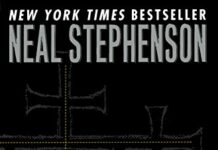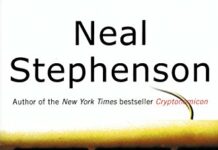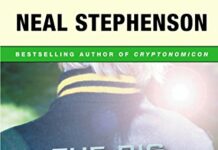
Ebook Info
- Published: 2012
- Number of pages: 899 pages
- Format: Epub
- File Size: 1.63 MB
- Authors: Neal Stephenson
Description
It is the late 1600s, on the high seas. A group of Barbary galley slaves plot as they ply the oars of a pirate ship, hatching a daring scheme to find an enormous cache of Spanish gold. Amazingly, they succeed – leaving some very unhappy men behind who vow to hunt down the vagabonds and bring them to justice, no matter the cost.
Meanwhile, back in France, the beautiful Eliza – toast of Versailles and spy extraordinaire – attempts to return to London with her baby, a child whose paternity is shrouded in mystery. Making her way home, her ship is stopped by a French privateer and she is returned to the Sun King’s court. Thrown back into a web of international intrigue, Eliza must contend with all manner of characters, including buccaneers, poisoners, Jesuits, financial manipulators, and even a stray cryptographer or two…
User’s Reviews
There is no Editorial Review for this book
Reviews from Amazon users, collected at the time the book is getting published on UniedVRG. It can be related to shiping or paper quality instead of the book content:
⭐ Neal Stephenson’s books all share a vital commonality: detail. And it is this very trait which turns his books into works of art.Breathtakingly awesome in their scope and length.I’m only part way through ‘Confusion’, but it flows on smoothly from ‘Quicksilver’ (volume 1 of 3 in the Barogue Cycle) and becomes even more enjoyable as the characters list gets longer but ever more entwined, the plot develops and slowly works its way to a satisfying climax (as in all his books).Word of warning: if you only like 200 page quickie reads where very forgettable plots come and go like a breath of hot air stirring in the tropics, Stephenson is NOT for you. Ya gotta have ‘balls’ to read what is like a summer storm developing into a full-blown Cat. 5 hurricane twisting and destroying preconceived ideas along the way, and then reconfiguring reality into something more satisfying and wonderful than you could ever have imagined possible. I’m a fast reader on a Kindle, but I continue to be amazed when (as right now) I see messages such as the book is 17% complete – but with 21 hours left to complete the book.I recommend Stephenson’s books in general and this 3 book Baroque Cycle series to all readers – especially if you appreciate continuity stemming from historical characters blended smoothly with accommodating reality based fiction replete with intrigue, violence and sex (at times erotically intermingled).
⭐ I picked The Baroque Style to be the next book after my intro to Stephenson with Seveneves, largely due to the 4&1/2 star ratings of volumes 2 and 3, as they are the only Stephenson books rated that highly by Amazon readers. A quick glance at the reviews for The Confusion shows many comments to the effect that this was the favorite book of the three. Now that I’m 55% through volume 3, The System of the World, I can now say that I agree with those comments and absolutely loved The Confusion. Stephenson adds a lot of action to the story in this volume, and Jack Shaftoe takes center stage, whereas Eliza and Daniel Waterhouse were the stars of Quicksilver, volume 1. But otherwise The Confusion is more of what makes this series great, brilliant storytelling and intrigue, lots of laugh out loud dry humor, Stephenson teaching as usual about so many different topics, and a wonderful and detailed look at the lives and loves of prominent and common people living in France, England and The Netherlands. Oh, and the dialogue. I have never been captured and held by dialogue before, and as with the first volume, even without the action in this volume, I would come back solely for the dialogue. I have concluded that Neal Stephenson is the most entertaining author I have read.
⭐ I haven’t yet finished the trilogy–I’m on book 3 right now, “The System of the World.” There’s a lot of stuff here, three big books, several protagonists whose stories connect loosely or tightly. But I am loving this read! I was attracted to the trilogy because I’ve read a lot of the science fiction books by Neal Stephenson. The Baroque Cycle isn’t exactly science fiction. but it comes close, and like much of Stephenson’s work, it’s a geeks’ delight. Being a retired physics teacher I especially enjoy the imagined interactions between all those folks whose names I knew and whose works I admired throughout my career–Newton of course, Leibniz, Hooke, Huygens, Boyle, Newcomen. But it isn’t just the famous folks. Stephenson’s invented characters are fascinating. And the things he has them do…! Without giving away anything that might spoil a potential reader’s pleasure, I ask you to consider: how would an seventeenth-century lady who also happens to be a spy take notes on her observations without being conspicuous about it? How could knowledge of resonance frequency save a commercial ship carrying a cargo of a very dense liquid from wreck? And how to explain a group of galley slaves singing hava-nagila? Read it, and find out!
⭐ This book is a masterpiece of fiction. Set in the last 25years of the 17th century, lots of things happen, intrigues in the French royal court where a cunning and manipulative king reings, battles between the French, Dutch and English, a vagabond character that emphasizes with the reader, a slave, Eliza, turned Dhess who is a master of complex financial transactions. In truth, this is a book about commerce on a period of history when hard money was hard to find ( piracy was a part of it). Extraordinary!!!!
⭐ Like much of Stephenson’s later work, the Baroque Cycle ties in interesting discussions and exploration of factual content with an overarching fictional narrative. Cryptonomicon delved into WWII history, mathematics, and cryptography; Anathem looked at philosophy and quantum mechanics; Seveneves goes into depth on orbital mechanics and various related topics. Similarly, the Baroque Cycle covers economics and world history, with various stops to look at natural philosophy, alchemy, and a variety of other topics. The Baroque cycle has been tougher for me to get into than most of Stephenson’s other work, quite possibly because while I have a keep interest and pre-existing knowledge about many of his other topics of focus, I didn’t know nearly as much about history prior to reading these novels.The overarching plot is engaging, and there are many points in the dialogue where I found myself laughing out loud. For the most part, the book is very enjoyable. There are some parts of the writing that become tedious, however, particularly when long, graphic descriptions are given to various settings or long lists of things are spilled out – something which when reading could be skipped, but in audiobook form grows tiresome rapidly. The constantly changing narrative style is a direction that I don’t particularly care for – the narration changes at times between third person, first person letters, screenplays, meeting notes, and a number of techniques. I found these changes to be a distraction rather than adding to the feel of the work.The audiobook performance is excellent – the voices vary between characters and have good emotion and great pronunciation. I would prefer it if the audiobook tracks had some correspondance to the physical book so it were more possible to jump between the two, but you can’t have everything, I guess.
⭐ The Confusion is Volume II of the author’s Baroque Cycle. Volume I contains the first three “books” of the cycle, while The Confusion contains Book 4 (Juncto) and Book 5 (Bonanza). These two books were originally published separately, but when combined in this volume, the “chapters” are alternated so as to maintain chronological order. That is because the two books deal with two completely separate story lines.Juncto is set in northern Europe and features Eliza, Duchess of Arcachon and Qwhglm, and Daniel Waterhouse. Bonanza follows the adventures of Half-Cocked Jack Shaftoe from his days as a galley slave along the Barbary Coast through Egypt, the Indian sub-continent (Hindoostan), the Far East, New Spain (Mexico) and ultimately back to England.If you read Volume I, Quicksilver, or the three books that were encompassed therein, then you are familiar with the characters and the historical landscape (late 17th, early 18th century). While the historical fiction contained in these works is highly educational and at times fascinating (at others, somewhat confusing), this is not my favorite Stephenson effort. Nevertheless, as in his cyberpunk and sci-fi stories, a certain level of attention and effort is required in order fully grasp the author’s work. Some may not want to put forth the effort, but I appreciate it.
⭐ The second volume of Neal Stephenson’s epic Baroque Cycle (Qucksilver being the first) is just as insanely awesome as its predecessor. Are there pirates? Oh yes. Are there complex discourses on the progress of enlightenment era philosophy and match? Of course! Are there comically perfect insertions of fictional characters into real history, but with a subtle understanding of how small events in the late 1600s and early 1700s led to our modern world? In spades! I’ve read this entire series twice, and it was well worth the effort – it is a lunatic undertaking to write a multi-volume “science fiction historical novel” about a period that most modern readers don’t know, but Stephenson pulls it off with aplomb. Are there a few slow moments? In a project this size it would be shocking if there weren’t. But the vast majority of this huge doorstop of a book is crazily entertaining, and whether he’s talking about counterfeiting, corsairs, Indian insect hospitals, the fight over the invention of calculus, the court of Louis XIV, or Spanish noblemen with Tourette’s Syndrome, Stephenson’s imagination is never anything short of overwhelming. Highly recommended (although you have to read Quicksilver first).
⭐ A great read for people that love detail. Stephenson writes as it was in the 1600’s including grammer so it takes awhile to get used to the syntax, but once engrossed in the gigantic plot it is an incredible journey. A real history lesson in Isaac Newton, his theories, The Royal Society, natural philosophy, England, Economics, cryptology, taxomony, the invention of banks and financing, the invention of the stock market, the plague, the Church of England, Versailles and Louis the 14th, Germany, the slave trade, India, Sailing in unknown waters, international trade, computers [yes in the 1600’s], watches, IED’s and innumerable other subjects. This novel is unlike anything I have ever read, Stepehenson’s attention to detail is amazing, and I couldn’t put it down for long. This novel shows that almost all that we think as modern is 300 years old or older, just applied differently. This is just book 2 or a three book saga. Make sure to read Quicksilver first as it sets the stage for all that happens in this novel. Book three of the Baroque Cycle is The System of the World and they all make up a wonderful story that you don’t want to end.
⭐ Isaac Asimov’s Foundation Trilogy/Series is considered one of the great science-fiction collections ever written, forming the basis of countless derivative and inspired works over the past fifty years. The Baroque Cycle will not, unfortunately, inspire fifty years of copycats, for a unique reason: it would be far too difficult to undertake with even moderate effort. This is a nine-book/ three-volume masterpiece of historical fiction that really has no peer in my experience (and please comment if you find any!)As an aside, I could, at length, review each of the nine books and prattle on endlessly about this or that, but that’s far too many reviews for what I intend to say about the Cycle as a whole. My comments apply to all books equally.The cycle begins in the mid 17th century and spans the adulthood of one Daniel Waterhouse, a fictional contemporary of Isaac Newton. Of course, it also traces the life of one Jack Shaftoe, a fictional hero with his roots in every pirate story ever written or filmed. And then there’s the mysterious Enoch Root, popping up again from the Cryptonomicon to move things along as the deux ex machina of certain story elements.The number of interleaved story lines would be an impressive enough feat of writing, but the historical references were simply amazing. The sheer amount of research Mr. Stephenson invested for the Cycle must have been enormous. In short, Mr. Stephenson describes London before, during, and after the Great Fire of 1666 politically, sociologically, geographically, architecturally, and economically; he performs the same rigor of place-setting with Hanover and present-day Germany, Paris and present-day France, diverse parts of Egypt, Algeria, India, Mexico, South America, and Boston. This is the kind of book series that would inspire high-school students to PAY ATTENTION. For, if the students really do their homework and have a teacher partnered with them to put the book details into their proper context, you could quite possible craft an entire school year around the nine books, such is the depth and breadth of scholastic research involved in putting together such a series. It’s no small achievement or idle boast: Mr. Stephenson has in some way taken his education and put it to its greatest use, as an inspiration to students.All of this would be for naught if the stories weren’t truly excellent at their core, and they are. You could boil down the Shaftoe story line to “pirate story” but that sells it short after the first book — and there are eight more to go. What starts as a pirate story quickly become something of a precursor to spycraft and terrorism/counter-terrorism in the 17th and 18th centuries: currency manipulation, political scandals, and assassinations. I haven’t even mentioned Isaac Newton versus Gottfried Leibniz in the battle for Calculus, or Isaac Newton’s Alchemy, the reconstruction of London post-fire, the gold trade, the silver trade, piracy in the Atlantic and Pacific, the timber economy, the commodities exchange of northern Europe, the court at Versailles, and so on. I’m astonished as I write this.This is well-worth the time invested to read, as a Cycle. If Mr. Stephenson ever posted his complete bibliography, or if some doctoral student ever decided to craft that two-semester, eight-course class tracing the book’s scholarship, I would be among the first to delve deeply into it and re-learn my forgotten history, mathematics, and economics. Simply, this is one of the finest fiction series ever written.-Fred
⭐ Two stories twine together in this second installment of the adventures of Jack Shaftoe and Eliza, as the plot within a plot, within a plot grows more complex still. The author finally resolves the divers strands and sets up the scene for volume three. This is history shown in a grand sweep. Highly recommended.
Keywords
Free Download The Confusion (The Baroque Cycle Book 2) in Epub format
The Confusion (The Baroque Cycle Book 2) Epub Free Download
Download The Confusion (The Baroque Cycle Book 2) 2012 Epub Free
The Confusion (The Baroque Cycle Book 2) 2012 Epub Free Download
Download The Confusion (The Baroque Cycle Book 2) Epub
Free Download Ebook The Confusion (The Baroque Cycle Book 2)




